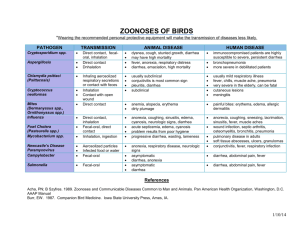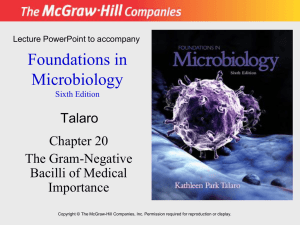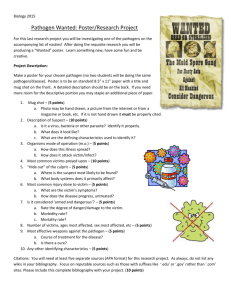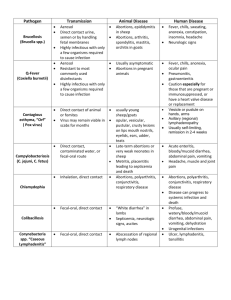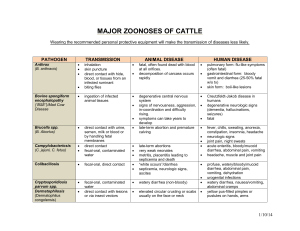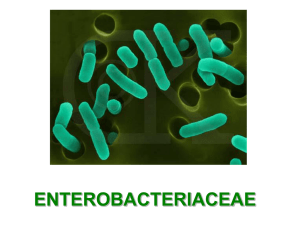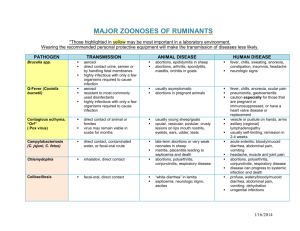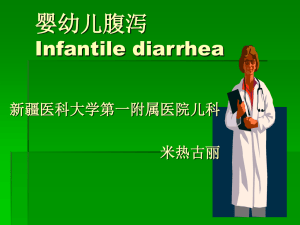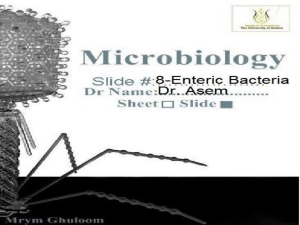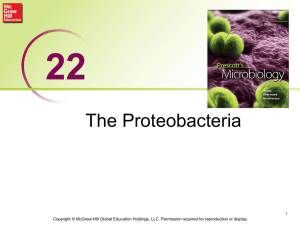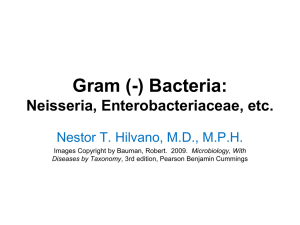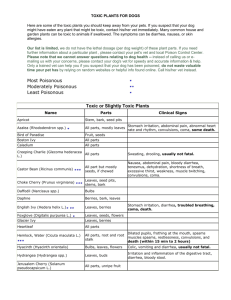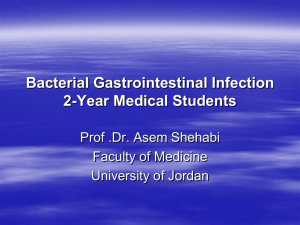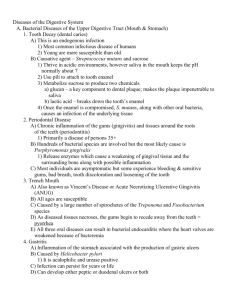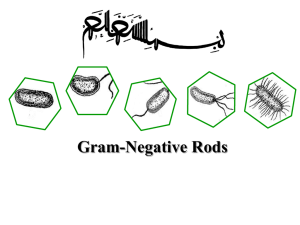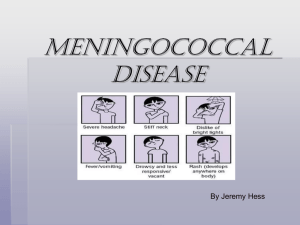Gram Negative Bacilli of Med Imp
advertisement
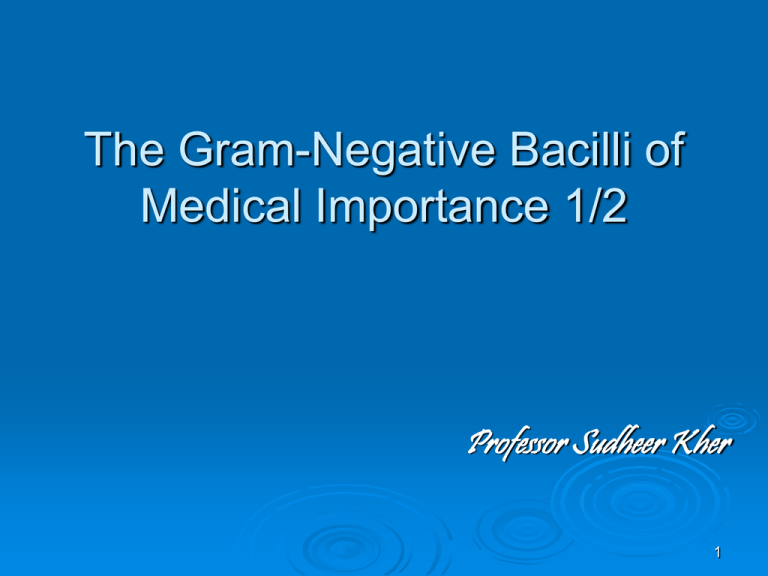
The Gram-Negative Bacilli of Medical Importance 1/2 Professor Sudheer Kher 1 Learning Objectives 1. 2. 3. 4. 5. 6. Enlist medically important GNBs Explain the basis of classification of GNBs General properties of enterobacteriaceae Discuss the role of toxins and other virulence factors in pathogenesis Describe the mechanism of action of various toxins6. List pathogenicity Resources - Ananthnarayan 2 Representative Gram-negative Bacilli 1. Gram-negative rods a. Family Enterobacteriaceae Medically important species Escherichia coli, Salmonella enterica, Shigella, Klebsiella spp, Proteus spp b. Pseudomonas spp related Organisms 2. Curved rods • Vibrio spp • Campylobacter spp • Helicobacter spp 3.Miscellaneous Legionella spp Chlamydia spp Rickeettsia c. Bordetella pertussis d. Haemophilus spp 3 Septic Shock-Endotoxic shock LPS Release of LPS as bacteria breaks apart (lipopolysacchardide) Component of Gram negative cell wall is a potent immune stimulant. May lead to circulatory failure, tissue damage and death 4 5 Aerobic Gram-Negative Bacilli Pseudomonas – an opportunistic pathogen Brucella & Francisella – zoonotic pathogens Bordetella & Legionella – mainly human pathogens 6 Pseudomonas small gram-negative rods with a single polar flagellum, produce oxidase & catalase highly versatile metabolism 7 Pseudomonas aeruginosa common inhabitant of soil & water (ubiquitous-wide spread) intestinal resident in 10% normal people grapelike odor greenish-blue pigment (pyocyanin) resistant to soaps, dyes, quaternary ammonium disinfectants, drugs, drying frequent contaminant of ventilators, IV solutions, anesthesia equipment opportunistic pathogen 8 Pseudomonas aeruginosa common cause of nosocomial infections in hosts with burns, neoplastic disease, cystic fibrosis Can cause: pneumonia, UTI, abscesses Septicemia can lead to: endocarditis, meningitis, bronchopneumonia Corneal ulcers from contaminated lens solutions Ear infections (Otitis) “swimmer’s ear” Skin rash (contaminated hot tubs, saunas, swimming pools) multidrug resistant 9 Brucella tiny gram-negative coccobacilli 2 species Brucella abortus (cattle) Brucella suis (pigs) Brucellosis (synonyms=malta fever, undulant fever, & Bang disease) – a zoonosis transmitted to humans from infected animals fluctuating pattern of fever –weeks to a year combination of tetracycline & rifampin or streptomycin animal vaccine available (efforts underway to eradicate from cattle herds and swine) 10 potential bioweapon Brucellosis Undulating fever 11 Francisella tularensis causes tularemia, a zoonotic disease of mammals endemic to the northern hemisphere, particularly rabbits transmitted by contact with infected animals, water & dust or bites by vectors headache, backache, fever, chills, malaise & weakness 10% death rate in systemic & pulmonic forms intracellular persistence can lead to relapse gentamicin or tetracycline attenuated vaccine available potential bioterrorism agent 12 Bordetella pertussis minute, encapsulated coccobacillus causes pertussis or whooping cough, a communicable childhood affliction acute respiratory syndrome often severe, life-threatening complications in babies reservoir – apparently healthy carriers transmission by direct contact or inhalation of aerosols May be relatively common in adults (as chronic cough) and be misdiagnosed as a cold or the flu 13 Bordetella pertussis virulence factors receptors that recognize & bind to ciliated respiratory epithelial cells toxins that destroy & dislodge ciliated cells loss of ciliary mechanism leads to buildup of mucus & blockage of the airways Hacking coughs followed by abrupt deep inhalation (whoop) Vaccine does not give long-term immunity so adults and older children can have a recurrence 14 Time course 15 Legionella pneumophilia 16 Legionella pneumophila widely distributed in water live in close association with amebas 1976 epidemic of pneumonia afflicted 200 American Legion members attending a convention in Philadelphia & killed 29 (source was a contaminated air-conditioning system) Legionnaires disease Most prevalent in males over 50 nosocomial disease in elderly patients Symptoms: fever, cough, diarrhea, abdominal pain, pneumonia fatality rate of 3-30% azithromycin 17 Enterobacteriaceae Family Large family of gram-negative non sporing rods, motile / non motile Reduce nitrates to nitrites Catalase positive Oxidase negative Do not produce pigments. many members inhabit soil, water, & decaying matter & common occupants of large bowel of humans & animals facultative anaerobes, grow best in air Cause diarrhea through enterotoxins Divided into coliforms (lactose fermenters) and non-coliforms (non lactose fermenters) 18 Diarrheal Disease Two Mechanisms Toxigenic • Organism itself does not invade the tissue • Enterotoxins released which cause cells to increase secretion secretory diarrhea Invasive • Microbes breakdown epithelial cells and form ulcerations. May see bleeding Fluid and electrolyte loss may result in dehydration…death. Diarrheal disease = 40% of infectious diseases 18% of death worldwide 19 Nosocomial Infections Nosocomial infections from Gram negative enterics 20 Coliforms- Ferment lactose. (normal enteric flora but may cause infections) Noncoliforms- Do not ferment lactose. (some are normal enteric flora others are true pathogens…Salmonella, Shigella) 21 Escherichia coli most common aerobic & non-fastidious bacterium in gut enterotoxigenic E. coli causes severe diarrhea due to heat-labile toxin & heat-stable toxin – stimulate secretion & fluid loss; also has fimbrae enteroinvasive E. coli causes inflammatory disease of the large intestine enteropathogenic E. coli linked to wasting form infantile diarrhea; O157:H7 strain causes hemorrhagic syndrome & kidney damage 22 Escherichia coli pathogenic strains frequent agents of infantile diarrhea – greatest cause of mortality among babies causes ~70% of traveler’s diarrhea causes 50-80% UTI indicator of fecal contamination in water 23 E. coli O157:H7 • 70,000 cases annually • Bloody diarrhea, hemorrhagic colitis, hemolytic uremic syndrome • Displaces normal, harmless strains in Intestines • Produces shiga-like toxin (kills host cells) 24 Other coliforms Klebsiella pneumoniae– normal inhabitant of respiratory tract, has large capsule, cause of nosocomial pneumonia, mennigitis, bacteremia, wound infections & UTIs Enterobacter – UTIs, surgical wounds Serratia marcescens – produces a red pigment; causes pneumonia, burn & wound infections, septicemia & meningitis Citrobacter – opportunistic UTIs & bacteremia 25 Capsule of Klebsiella pneumoniare 26 Noncoliform lactose-negative enterics Proteus Salmonella & Shigella 27 Proteus Swarm on surface of moist agar in a concentric pattern Cause UTI, wound infections, pneumonia, septicemia, & infant diarrhea 28 Salmonella typhi & S. paratyphi A, B, C – typhoid fever – ingested bacilli adhere to small S. intestine, cause invasive diarrhea that leads to septicemia. Asymptomatic carriers perpetuate and spread the bacteria. enteritidis – 1,700 serotypes (varieties)salmonellosis – can be zoonotic (fecal S. contamination of food products) (1/3 of all chickens have Salmonella) Food Poisoning-gastroenteritis for 2-5 days 29 Phases of Typhoid Fever Invasion Septicemia 30 Typhoid Mary 31 Shigella Shigellosis – bacillary dysentery •S. dysenteriae, S. sonnei, S. flexneri & S. boydii •Invades large intestine, can perforate intestine or invade blood (septicemia) •Virulence factors: endotoxin & exotoxins •Treatment – fluid replacement & in complicated cases ciprofloxacin & sulfa-trimethoprim Patches of mucus and blood 32 33
